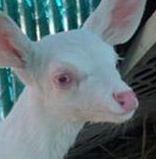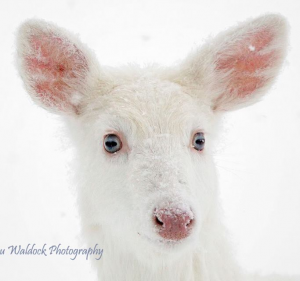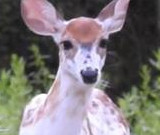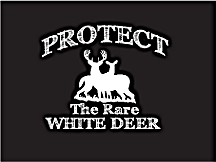
Genetics and the Making of a White Deer
What makes a white deer white? How is it inherited, and how does hunting or not hunting affect white deer populations? It all goes back to genes…
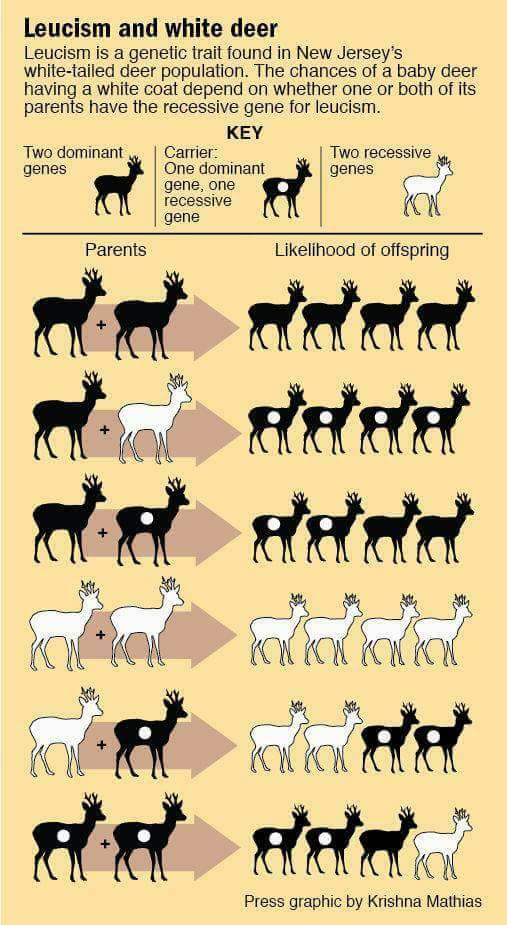
This is an excellent chart for understanding the inheritance of white genes. The antlered deer can represent either bucks or does. Graphic by Krishna Mathias.
White Deer Genetics 101: The Basics
All characteristics in deer (and animals in general) are passed on by cellular units called genes. Genes can be dominant (expressing a trait) or recessive (covered up or hidden in the presence of a dominant gene).
Offspring receive or inherit one gene for each characteristic from each parent, so the genes occur in pairs. Combinations of genes for coat color in deer include brown/brown, brown/white, and white/white.
Because brown is dominant, the only gene combination that can produce a white fawn is white/white. White is already an extremely rare gene, so this further decreases the odds of a fawn being born white.
The more white genes there are in a population, however, the higher the chance of getting white fawns. Barriers that restrict the movement of breeding adults can also increase the chances of two white genes coming together. (See Seneca white deer herd)
If a fawn has a gene for both colors (brown/white), it will be brown, but it still carries the white gene and can pass that on to future offspring. This brown deer is known as a “carrier.”
Landowners who protect the white deer on their property but who think nothing of hunting the white deer’s companions (often the deer’s family members) may inadvertently be removing white genes from the population.
Conversely, hunters who view white deer as defective and want to hunt them don’t understand that shooting just the white deer will not get rid of the carrier genes. On the up side, when a valued white deer is lost, there is a chance the white genes will appear again in another individual. (See article on front page: “Her Name Is Snow White”–April 15, 2018)
White Deer Genetics 102: Albino, Piebald, and Leucistic Deer
Genetics, however, is not so simple as this chart indicates. Coat color is actually caused by many genes that affect the pigments, enzymes, and hormones involved in color production—or, in this case, the absence of color. Other genes can also affect the division and movement of pigment cells in early development.
Leucism (white coat color) and albinism (a total lack of color in all parts of the body) are actually two very different conditions caused by two very different genes.
Albinos: Albinos have pigment-producing cells (melanocytes), but lack the enzyme tyrosinase that is essential for the production of melanin, the dark pigment responsible for color. There is technically no such thing as a partial albino since albinism (lack of tyrosinase) is an all-or-nothing condition. Albinos typically have blue or pink eyes (caused by blood vessels showing through the iris). Because melanin is also involved in eye development, albinos can have impaired eyesight, but in all other respects are as normal and healthy as regular deer.
Leucistic deer: Color in “white” or leucistic deer, on the other hand, is the result of a gene that causes a total lack of melanocytes in the coat. In the case of albinism, the “car” is there, but there’s no driver. In leucism, there are simply “no cars.” What happens in this situation is that melanocytes either don’t form in early embryonic development or fail to migrate to the coat (the “cars” don’t make it off the production line). Eye color in this case has a different source of pigments so is not affected–hence the normal brown eyes in white deer.
Piebalds: If just some of the melanocytes migrate from their embryonic source to the coat, the deer can develop patches of brown color and is referred to as a piebald. This is technically known as partial-leucism (sometimes incorrectly called partial-albinism). Partially leucistic animals are common in dogs, cats, and horses—and are often bred for such traits because of their beautiful coats. Piebald fawns can occasionally have physical defects if other changes occur in early embryological development, but it is not a given. Most piebalds are perfectly normal.
White Deer Genetics: Answering the Big Questions
Are white deer inferior? No, they are simply different. Recessive isn’t another word for defective; it just means that traits like coat color can be genetically hidden. And mutations are simply changes in genes—whether good or bad. Without genetic change, there would be no diversity and no evolution.
Do white deer need to be removed from the population? No more than white rabbits, spotted dogs, calico cats, or red-haired people. If white deer were truly weak they wouldn’t survive, but when not hunted they seem to do just fine.
Will white and albino deer ever become common? Not likely. Because the genes are so rare and so seldom expressed, the appearance of any white or albino deer will continue to be a rare and unexpected occurrence.
Has modern science taken away some of the wonder of these amazing deer? Not at all. Figuring out the science behind color solves some of the mysteries of the white deer, but they remain no less magical.
For additional information on the genetics of coat color in animals, be sure to read these very interesting articles:
Albinism and leucism: origins and differences
Why are some squirrels of the same species different colours?


